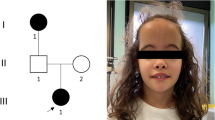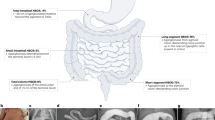Abstract
Prenatal trisomy 7 is usually a cell culture artifact in amniocytes with normal diploid karyotype at birth and normal fetal outcome. In the same way, true prenatal trisomy 7 mosaicism usually results in a normal child except when trisomic cells persist after birth or when trisomy rescue leads to maternal uniparental disomy, which is responsible for 5.5–7% of patients with Silver–Russell syndrome (SRS). We report here on the unusual association of SRS and Hirschsprung's disease (HSCR) in a patient with maternal uniparental heterodisomy 7 and trisomy 7 mosaicism in intestine and skin fibroblasts. HSCR may be fortuitous given its frequency, multifactorial inheritance and genetic heterogeneity. However, the presence of the trisomy 7 mosaicism in intestine as well as in skin fibroblasts suggests that SRS and HSCR might possibly be related. Such an association might result from either an increased dosage of a nonimprinted gene due to trisomy 7 mosaicism in skin fibroblasts (leading to SRS) and in intestine (leading to HSCR), or from an overexpression, through genomic imprinting, of maternally expressed imprinted allele(s) in skin fibroblasts and intestine or from a combination of trisomy 7 mosaicism and genomic imprinting. This report suggests that the SRS phenotype observed in maternal uniparental disomy 7 (mUPD(7)) patients might also result from an undetected low level of trisomy 7 mosaicism. In order to validate this hypothesis, we propose to perform a conventional and molecular cytogenetic analysis in different tissues every time mUPD(7) is displayed.
Similar content being viewed by others
Log in or create a free account to read this content
Gain free access to this article, as well as selected content from this journal and more on nature.com
or
References
Magenis E, Webb MJ, Spears B, Opitz JM : Blaschkolinear malformation syndrome in complex trisomy-7 mosaicism. Am J Med Genet 1999; 87: 375–383.
Hodes ME, Gleiser S, DeRosa GP et al: Trisomy 7 mosaicism and manifestations of Goldenhar syndrome with unilateral radial hypoplasia. J Craniofac Genet Dev Biol 1981; 1: 49–55.
Jenkins D, Martin K, Young ID : Hypomelanosis of Ito associated with mosaicism for trisomy 7 and apparent ‘pseudomosaicism’ at amniocentesis. J Med Genet 1993; 30: 783–784.
Verghese S, Newlin A, Miller M, Burton BK : Mosaic trisomy 7 in a patient with pigmentary abnormalities. Am J Med Genet 1999; 87: 371–374.
Kayser M, Henderson LB, Kreutzmann J, Schreck R, Graham Jr JM : Blaschkolinear skin pigmentary variation due to trisomy 7 mosaicism. Am J Med Genet 2000; 95: 281–284.
Kalousek DK, Howard-Peebles PN, Olson SB et al: Confirmation of CVS mosaicism in term placentae and high frequency of intrauterine growth retardation association with confined placental mosaicism. Prenat Diagn 1991; 11: 743–750.
Kalousek DK, Langlois S, Barrett IJ et al: Uniparental disomy for chromosome 16 in humans. Am J Hum Genet 1993; 52: 8–16.
Kalousek DK, Langlois S, Robinson WP et al: Trisomy 7 CVS mosaicism: pregnancy outcome, placental and DNA analysis in 14 cases. Am J Med Genet 1996; 65: 348–352.
Wolstenholme J : Confined placental mosaicism for trisomies 2, 3, 7, 8, 9, 16 and 22: their incidence, likely origins, and mechanisms for cell lineage compartmentalization. Prenat Diagn 1996; 16: 511–524.
Hsu LY : United States survey on chromosome mosaicism and pseudomosaicism in prenatal diagnosis. Prenat Diagn 1984; 4: 97–130.
Hsu LYF, Kaffe S, Jenkins EC et al: Proposed guidelines for diagnosis of chromosome mosaicism in amniocytes based on data derived from chromosome mosaicism and pseudomosaicism studies. Prenat Diagn 1992; 12: 555–573.
Hsu LY, Yu MT, Neu RL et al: Rare trisomy mosaicism diagnosed in amniocytes, involving an autosome other than chromosomes 13, 18, 20, and 21: karyotype/phenotype correlations. Prenat Diagn 1997; 17: 201–242.
Kivirikko S, Salonen R, Salo A, Von Koskull H : Prenatally detected trisomy 7 mosaicism in a dysmorphic child. Prenat Diagn 2002; 22: 541–544.
Bilimoria KY, Rothenberg JM : Prenatal diagnosis of a trisomy 7/maternal uniparental heterodisomy 7 mosaic fetus. Am J Med Genet 2003; 118A: 60–63.
Kotzot D, Schmitt S, Bernasconi F et al: Uniparental disomy 7 in Silver–Russell syndrome and primordial growth retardation. Hum Mol Genet 1995; 4: 583–587.
Eggermann T, Wollmann HA, Kuner R et al: Molecular studies in 37 Silver–Russell syndrome patients: frequency and etiology of uniparental disomy. Hum Genet 1997; 100: 415–419.
Preece MA, Price SM, Davies V et al: Maternal uniparental disomy 7 in Silver–Russell syndrome. J Med Genet 1997; 34: 6–9.
Price SM, Stanhope R, Garrett C, Preece MA, Trembath RC : The spectrum of Silver–Russell syndrome: a clinical and molecular genetic study and new diagnostic criteria. J Med Genet 1999; 36: 837–842.
Kotzot D, Balmer D, Baumer A et al: Maternal uniparental disomy 7 – review and further delineation of the phenotype. Eur J Pediatr 2000; 159: 247–256.
Hitchins MP, Stanier P, Preece MA, Moore GE : Silver–Russell syndrome: a dissection of the genetic aetiology and candidate chromosomal regions. J Med Genet 2001; 38: 810–819.
Hannula K, Kere J, Pirinen S, Holmberg C, Lipsanen-Nyman M : Do patients with maternal uniparental disomy for chromosome 7 have a distinct mild Silver–Russell phenotype? J Med Genet 2001; 38: 273–278.
Kotzot D : Review and meta-analysis of systematic searches for uniparental disomy (UPD) other than UPD 15. Am J Med Genet 2002; 111: 366–375.
Langlois S, Yong SL, Wilson RD, Kwong LC, Kalousek DK : Prenatal and postnatal growth failure associated with maternal heterodisomy for chromosome 7. J Med Genet 1995; 32: 871–875.
Amiel J, Lyonnet S : Hirschsprung disease, associated syndromes, and genetics: a review. J Med Genet 2001; 38: 729–739.
Joyce CA, Sharp A, Walker JM, Bullman H, Temple IK : Duplication of 7p12.1–p13, including GRB10 and IGFBP1, in a mother and daughter with features of Silver–Russell syndrome. Hum Genet 1999; 105: 273–280.
Monk D, Wakeling EL, Proud V et al: Duplication of 7p11.2–p13, including GRB10, in Silver–Russell syndrome. Am J Hum Genet 2000; 66: 36–46.
Eggermann T, Meyer E, Wollmann HA : Quantification of GRB10 in 7p12–p14 by fluorogenic 5′ nuclease chemistry and application for genetic diagnosis in Silver–Russell syndrome. Ann Genet 2004; 47: 99–102.
Blagitko N, Mergenthaler S, Schulz U et al: Human GRB10 is imprinted and expressed from the paternal and maternal allele in a highly tissue- and isoform-specific fashion. Hum Mol Genet 2000; 9: 1587–1595.
Mergenthaler S, Hitchins MP, Blagitko-Dorfs N et al: Conflicting reports of imprinting status of human GRB10 in developing brain: how reliable are somatic cell hybrids for predicting allelic origin of expression? Am J Hum Genet 2001; 68: 543–544.
McCann JA, Zheng H, Islam A, Goodyer CG, Polychronakos C : Evidence against GRB10 as the gene responsible for Silver–Russell syndrome. Biochem Biophys Res Commun 2001; 286: 943–948.
Eggerding FA, Schonberg SA, Chehab FF, Norton ME, Cox VA, Epstein CJ : Uniparental isodisomy for paternal 7p and maternal 7q in a child with growth retardation. Am J Hum Genet 1994; 55: 253–265.
Myioshi O, Kondoh T, Taneda H, Otsuka K, Matsumoto T, Niikawa N : 47,XX,UPD(7)mat, +r(7)pat/46,XX,UPD(7)mat mosaicism in a girl with Silver–Russell syndrome (SRS): possible exclusion of the putative SRS gene from a 7p13–q11 region. J Med Genet 1999; 36: 326–329.
Nakabayashi K, Fernandez BA, Teshima I et al: Molecular genetic studies of human chromosome 7 in Silver–Russell syndrome. Genomics 2002; 79: 186–196.
Hannula K, Lipsanen-Nyman M, Kontiokari T, Kere J : A narrow segment of maternal uniparental disomy of chromosome 7q31–qter in Silver–Russell syndrome delimits a candidate gene region. Am J Hum Genet 2001; 68: 247–253.
Bentley L, Nakabayashi K, Monk D et al: The imprinted region on human chromosome 7q32 extends to the carboxypeptidase A gene cluster: an imprinted candidate for Silver–Russell syndrome. J Med Genet 2003; 40: 249–256.
Attie T, Pelet A, Edery P et al: Diversity of RET proto-oncogene mutations in familial and sporadic Hirschsprung disease. Hum Mol Genet 1995; 4: 1381–1386.
Angrist M, Bolk S, Bentley K, Nallasamy S, Halushka MK, Chakravarti A : Genomic structure of the gene for the SH2 and pleckstrin homology domain-containing protein GRB10 and evaluation of its role in Hirschsprung disease. Oncogene 1998; 17: 3065–3070.
Pandey A, Duan H, Di Fiore PP, Dixit VM : The Ret receptor protein tyrosine kinase associates with the SH2-containing adapter protein GRB10. J Biol Chem 1995; 270: 21461–21463.
Angrist M, Bolk S, Halushka M, Lapchak PA, Chakravarti A : Germline mutations in glial cell line-derived neurotrophic factor (GDNF) and RET in a Hirschsprung disease patient. Nat Genet 1996; 14: 341–344.
Hitchins MP, Monk D, Bell GM et al: Maternal repression of the human GRB10 gene in the developing central nervous system; evaluation of the role for GRB10 in Silver–Russell syndrome. Eur J Hum Genet 2001; 9: 82–90.
Acknowledgements
We thank D Huot, S Florent, M Loriot, E Schmitt and S Viciana for their technical assistance and the patient's parents for their cooperation.
Author information
Authors and Affiliations
Corresponding author
Rights and permissions
About this article
Cite this article
Flori, E., Girodon, E., Samama, B. et al. Trisomy 7 mosaicism, maternal uniparental heterodisomy 7 and Hirschsprung's disease in a child with Silver–Russell syndrome. Eur J Hum Genet 13, 1013–1018 (2005). https://doi.org/10.1038/sj.ejhg.5201442
Received:
Revised:
Accepted:
Published:
Issue date:
DOI: https://doi.org/10.1038/sj.ejhg.5201442
Keywords
This article is cited by
-
Mosaic UPD(7q)mat in a patient with silver Russell syndrome
Molecular Cytogenetics (2017)
-
Effects of RET, NRG1 and NRG3 Polymorphisms in a Chinese Population with Hirschsprung Disease
Scientific Reports (2017)
-
Growth parameters in maternal uniparental disomy 7 and 14
European Journal of Pediatrics (2007)



